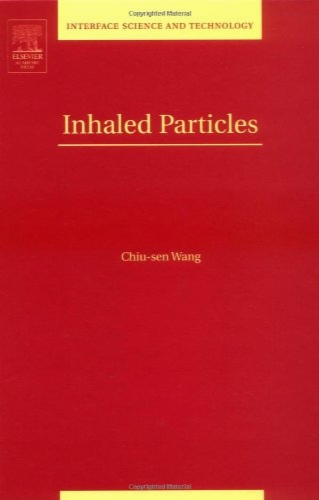Inhaled particles v. 5.
- نوع فایل : کتاب
- زبان : انگلیسی
- مؤلف : Chiu-sen Wang
- ناشر : Amsterdam ; Boston : Elsevier Academic Press,
- چاپ و سال / کشور: 2005
- شابک / ISBN : 9780120885794
Description
Preface xiii Glossary and Acronyms xv List of Principal Symbols xxi Chapter 1 Introduction 1 Problems 5 References 5 Chapter 2 Morphometry of the Human Respiratory System 7 2.1 The Head Airways Region 8 2.2 The Tracheobronchial Region 11 2.3 Anatomical Models of Lungs 15 2.4 Anatomical Models of Airway Bifurcations 24 2.5 The Alveolar Region 25 2.6 Variations in Airway Dimensions 26 2.7 Changes in Airway Dimensions during Respiration 27 Problems 28 References 28 Chapter 3 Airflow in the Respiratory System 31 3.1 Breathing Dynamics and Respiratory Volumes 31 3.2 Respiratory Physiology 33 3.3 Macroscopic Aspects of Airflow in Lung Airways 34 3.4 Local Aerodynamic Characteristics 36 3.4.1 General Concepts in Fluid Mechanics 36 3.4.2 Overview of Flow Patterns in Respiratory Airways 39 3.5 Flow in Head Airways 41 3.6 Flow in Tracheobronchial Airways 42 Vlll Contents 3.6.1 Effects of Successive Bifurcations 44 3.6.2 Effects of the Shape of Transition Zone 45 3.6.3 Effects of the Shape of Carinal Ridge 46 3.6.4 Effects of Surface Structure 46 3.6.5 Effects of Oscillatory Flow 47 3.7 Flow in the Alveolar Region 48 3.8 Summary of Flow Patterns in Airways 50 Problems 51 References 52 Chapter 4 Behavior of Aerosol Particles 55 4.1 Drag Force 57 4.2 Gravitational Settling 58 4.3 Interception 61 4.4 Inertial Impaction 61 4.5 Brownian Motion and Diffusion 66 4.6 Convective Brownian Diffusion 68 4.7 Deposition from Turbulent Flow 70 4.8 Electrostatic Forces 71 4.9 Growth of Hygroscopic Particles 73 4.10 Simultaneous Deposition by Several Mechanisms 75 Problems 76 References 77 Chapter 5 Dispersion of Inhaled Aerosol 79 5.1 General Concepts in Aerosol Dispersion 79 5.2 Aerosol Dispersion in Lung Airways 82 5.3 Gas Mixing in Lung Airways 84 Problems 85 References 85 Chapter 6 Inhalability of Ambient Particles 87 6.1 Mouth Inhalability 88 Contents ix 6.2 Nose Inhalability 91 Problems 91 References 91 Chapter 7 Deposition of Particles in the Respiratory System 93 7.1 General Concepts in Respiratory Deposition 93 7.2 Total and Regional Deposition 94 7.2.1 Relative Contributions of Various Mechanisms 95 7.2.2 Alveolar Deposition during Breath-Holding 97 7.3 Local Deposition 99 7.3.1 Deposition in Single Bifurcations 99 7.3.2 Effects of Successive Bifurcations 103 7.3.3 Deposition from Cyclic Flow 104 7.3.4 Deposition of Fibers in Single Bifurcations 104 Problems 105 References 106 Chapter 8 Experimental Studies on Total and Regional Deposition 108 8.1 Experimental Methods 108 8.1.1 Experimental Methods for Extrathoracic Deposition 109 8.1.2 Experimental Methods for Thoracic Deposition 110 8.1.3 Experimental Methods for Total Deposition 112 8.2 Deposition in Head Airways 112 8.2.1 Data from Human Subjects 112 8.2.2 Data from Casts 113 8.3 Deposition in the Tracheobronchial Region 115 8.4 Deposition in the Alveolar Region 118 8.5 Summary of Regional Deposition 119 8.6 Total Deposition 120 8.6.1 Deposition of Nonhygroscopic Particles 120 8.6.2 Deposition of Hygroscopic Particles 122 8.6.3 Deposition of Highly Charged Particles 122 x Contents Problems 123 References 124 Chapter 9 Deposition Models 127 9.1 Continuous Models 127 9.2 Compartments-in-Series Models 130 9.2.1 Typical Path Deposition Models 133 9.2.2 Single Path with Statistically Distributed Airway Dimensions 133 9.2.3 Tubes-and-Bifurcations-in-Series 134 9.3 The ICRP Deposition Model 135 9.3.1 Respiratory Tract Morphometry 13 5 9.3.2 Inhalability 136 9.3.3 Deposition in Extrathoracic Regions 136 9.3.4 Deposition in Thoracic Regions 137 9.3.5 Deposition of Hygroscopic Particles 139 9.3.6 Empirical Equations for Regional Deposition 139 9.4 The NCRP Deposition Model 140 9.4.1 Deposition in the Extrathoracic Region 141 9.4.2 Deposition in Thoracic Regions 142 9.5 Comparison of the ICRP and NCRP Models 144 9.6 Concluding Remarks 145 Problems 145 References 146 Chapter 10 Fate of Deposited Particles 149 10.1 Mechanisms of Particle Clearance 149 10.1.1 Mucociliary Transport 149 10.1.2 Phagocytosis 150 10.1.3 Entry into Lymphatic System 150 10.1.4 Absorption into Blood Circulation 150 10.2 Particle Clearance in Various Airway Regions 151 Contents xi 10.2.1 Extrathoracic Regions 152 10.2.2 Tracheobronchial Region 152 10.2.3 Alveolar Region 154 10.3 Particle Accumulation in Respiratory Airways 156 Problems 157 References 157 Chapter 11 Health Effects 159 11.1 Adverse Health Effects 159 11.1.1 Chemical Toxicants 159 11.1.2 Ambient Particles 161 11.1.3 Bacteria and Viruses 163 11.1.4 Radioactive Particles 164 11.2 Therapeutic Agents 165 Problems 165 References 166 Chapter 12 Applications 167 12.1 Health Risk Assessment 167 12.2 Aerosol Diagnosis 168 12.2.1 Aerosol Bolus Dispersion Test 169 12.2.2 Aerosol-Derived Airway Morphometry 170 12.3 Aerosol Therapy 171 12.3.1 Drug Formulations 172 12.3.2 Delivery Devices 172 12.3.3 Breathing Maneuvers for Targeting 173 Problems 175 References 176 Appendices 178 Al. Frequently Used Physical Constants 178 A2. Conversion Factors 178 A3. SI Prefixes 179 xii Contents A4. Properties of Air 179 A5. Properties of Aerosol Particles 180 Index 181


